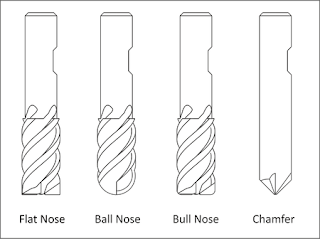Tốc độ cắt gọt (Cutting speess) và bước tiến (Feeds) là những thông số quan trọng của quá trình cắt gọt kim loại.
Những thông số này sẽ giúp ta chọn chế độ cắt gọt tối ưu trên các máy công cụ cắt gọt kim loại, kể cả các máy công cụ điều khiển số CNC..Nó rất quan trọng trong ngành gia công cơ khí chĩnh xác.
Đây là những công thức giúp ta có được lựa chọn tối ưu chế độc cắt gọt.
Nguồn tham khảo từ WWW.Cimco.com
Mọi người cũng tìm kiếm: Cutting Speeds and Feeds Formulas, Cutting Data, CAD/CAM, Dao Phay Dinh Hinh, Drill Cycles Speed Data, công nghệ chế tạo máy, Cutting Feeds, chế tạo máy, Hướng dẫn vẽ 3D,
The tool moves through
the material at a specified rotational speed, defined in revolutions per minute
(RPM), and feed rate, defined in inches per minute (IPM). Probably the most
vexing problem for the beginning CNC machinist is selecting proper cutting
speeds and feeds. This selection is actually more difficult on a CNC than a
manual mill because, with a manual mill, the operator can feel the cutting
pressure and alter the feed based in part on the cutting force.
CNC mills require
calculating speeds and feeds in advance. These speeds and feeds can, and often
are, adjusted at the machine based on chip shape and color, cutting sound, and
machine horsepower meter readings.
The best source of data
about cutting speeds and feeds for a specific tool, application, and material
is the tool supplier. Much of this data is found on manufacturer's web sites or
printed tooling catalogs. Tool sales representatives can be a valuable
resource, so if you do a lot of machining, develop a good relationship with a
knowledgeable representative.
Another source of speeds
and feeds data is CAD/CAM software. These have become increasingly
sophisticated and often provide good cutting data.
Yet even the best speed
and feed data is just a starting point. Speeds and feeds require adjustment due
to many factors including the maximum spindle speed or horsepower of the
machine, rigidity of work holding, and the quality and condition of the machine
tool itself.
The following pages
provide cutting data for the most commonly machined materials and a methodology
for calculating speeds and feeds. As always, use common sense. If the part is
held by double sided tape, feeds based on vise work holding are probably too
high. If the tool is very long and thin, speeds and feeds will likely require
reduction.
Speed Formula
Milling machine cutting
speeds are derived from the following formula:
 |
| Figure 3.14: Speed Formula |
|
Speed is the rotational
frequency of the tool (Spindle Speed) in revolutions per minute (RPM).
SFM (Surface Feet per
Minute) is the speed at which the material moves past the cutting edge (outside
diameter) of the tool in feet per minute. SFM values depend on the tool type,
tool material, and material being machined.
Circumference is the
circumference of the cutting tool in feet.
How Speed Formula is
Derived
Because cutting tools
are defined by their diameter in inches, this formula is rewritten and
simplified as follows:


|
|
|
Figure
3.15: Speed Formula (Simplified)
|
Dia is the tool diameter
in inches.
3.82 is a constant
derived from 12/pi which converts the tool circumference in feet to diameter in
inches.
Cutting feeds are in IPM
and use the following formula:
 |
Figure 3.16: Feed Formula
|
Feed is the linear feed
of the tool through the material in inches per minute.
Speed is the result of
the speed formula (Figure 3.15) in revolutions per minute.
CL is the chip load, or
how much material each cutting edge of the tool removes per revolution. Chip
load is sometimes referred to as feed per tooth (FPT) or inches per rev (IPR).
NumFlutes is the number
of cutting flutes. (For a twist drill, this value is one.)
Tap Feed Formula
For tapping operations,
feed rate is based on the number of threads per inch and feed rate:
|

|
|
Figure
3.17: Tap Feed Formula
|
Feed is the linear feed
of the tool through the material in inches per minute.
Speed is the result of
the speed formula (Figure 3.15) in revolutions per minute.
TPI is the threads per
inch of the tap. For example the TPI of a 1/4-20 tap is 20.











